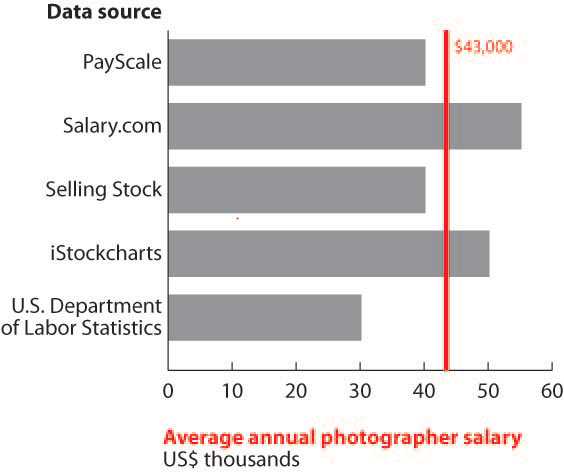Phrases like “it’s not all doom and gloom” pop up often, but those who offer such encouraging analysis are typically in the top tier of the profession. While their experience is certainly real and laudable if not amazing, is it representative enough to be touted as a roadmap to a successful career? Common sense, economics, mathematics and every available source of statistical information says no.
| Photography employment outlook through 2018 |
According to the U.S. Government, photographers should expect the decade ending 2018 to bring:
- Keen competition;
- Increased demand for portrait photography, presumably along with wedding and other consumer-oriented services;
- Increased demand for digital imagery;
- Growth of direct-to-buyer transactions and resulting growth of self-employment and decline of stock agencies;
- Reduced barriers to job entry and resulting constrained job growth;
- Decline of news, including print news specifically, and commercial photography;
- Decreasing salaried positions;
- New technology-derived opportunities; and
- Increased importance of business aptitude, creativity, experience, training and unique skills or talents.
Pretty amazing, but the U.S. Government predicted the direct-to-buyer trend in 2008: “The Internet and improved data management programs also should make it easier for freelancers to market directly to their customers, increasing opportunities for self-employment and decreasing reliance on stock photo agencies.”
Numerous other predictions from the same report also remain valid. For instance, “Those who succeed in landing a salaried job or attracting enough work to earn a living by freelancing are likely to be adept at operating a business and to be among the most creative.” Coming back to the group of photographers named earlier: all are successful businessmen that managed to expand beyond a single-producer model.
|
To dispense with the obvious: Indeed, it is not
all doom and gloom. Yuri Arcurs, Bill Bachmann, Ron Chapple, Jim Erickson and several others whose last names start with later letters of the alphabet will still make the kind of living that will make others’ eyes nearly pop out of their sockets. The
average photographer will not—and that, as opposed to any single industry star’s earnings, should be used as the benchmark when trying to forecast one’s most likely future prospects. Even the highest reported average salaries do not support the notion of a six-figure income for anything but the top couple of percent of all working photographers in all disciplines.
According to PayScale August 2010 data, staff photographers should consider themselves lucky if they break $40,000 some time in their forties, after having 20 or so years of experience. PayScale estimates that commercial photographers working in the United States earn $30,429 to $55,975 and still photographers—$26,275 to $49,280.
Salary.com currently puts the median expected salary for a typical U.S. photographer at $54,474. The top 25% of the field may exceed $63,000 per annum.
Inside the stock industry, Selling Stock’s most recent research puts median 2009 photographer income at $30,000 to $50,000. According to Jim Pickerell’s analysis of iStockcharts data, top 117 iStockphoto contributors averaged under $50,000 in 2009 earnings.
 U.S. Department of Labor Statistics told a similar story in 2008: Median annual wages of salaried photographers were $29,440, with the top 10% of photographers reporting over $62,000 in income. Two years ago, the Government calculated a total of 152,000 photographer jobs, with more than half self-employed. Contrary to popular belief, the Department of Labor says that at the end of the day, freelancers tend to earn less than staffers due to the high cost of doing business.
U.S. Department of Labor Statistics told a similar story in 2008: Median annual wages of salaried photographers were $29,440, with the top 10% of photographers reporting over $62,000 in income. Two years ago, the Government calculated a total of 152,000 photographer jobs, with more than half self-employed. Contrary to popular belief, the Department of Labor says that at the end of the day, freelancers tend to earn less than staffers due to the high cost of doing business.
To review: Five different sources of data, including a government research department, say a photographer working in the United States should expect to earn an annual salary in the low 40s. Six-figure returns are possible for a select few. Comfortable—even high—salaries are likely for a few thousand photographers. The rest should expect a relatively modest living.
And we have yet to even consider the recession.